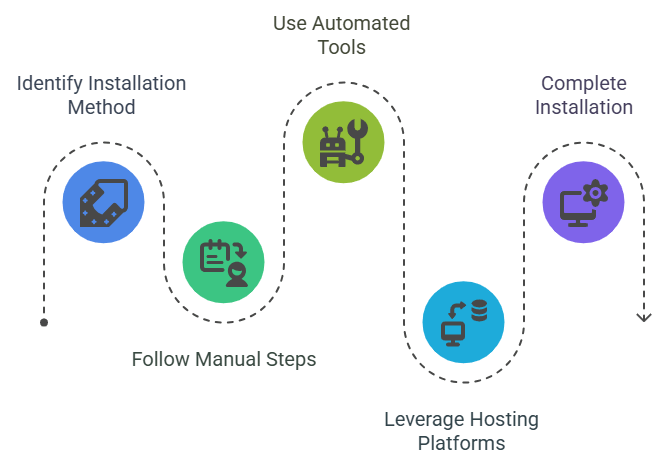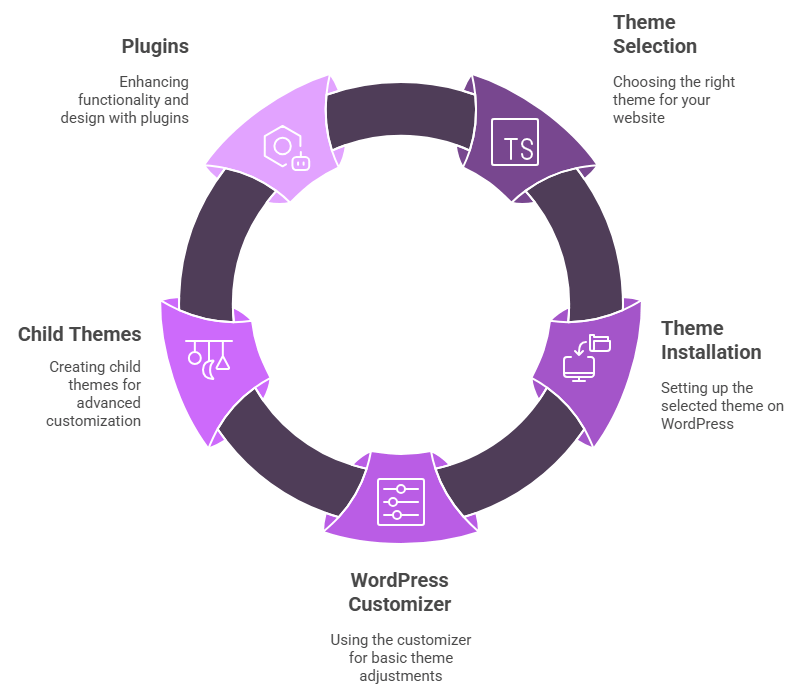
- Introduction to WordPress
- Installing WordPress
- Dashboard and User Interface
- Themes and Customization
- Plugins and Extensions
- WordPress for Blogging
- WordPress for E-Commerce (WooCommerce)
- SEO with WordPress
Introduction to WordPress
WordPress is a free and open-source content management system (CMS) that empowers users to create, manage, and maintain websites with remarkable ease. Developed using PHP and MySQL, WordPress’s core strength lies in its flexibility, user-friendliness, and the robust community that surrounds it. Originally launched in 2003 as a simple blogging platform, WordPress has since evolved into a comprehensive CMS capable of supporting a diverse range of websites, including blogs, business portals, e-commerce stores, portfolios, forums, and more. One of the key reasons for WordPress’s widespread popularity in Web Designing Training is its extensibility. Thousands of free and premium themes allow users to customize the appearance of their websites without needing advanced design skills. Similarly, plugins extend functionality, offering tools for SEO, security, performance optimization, e-commerce capabilities, and much more. This ecosystem of themes and plugins continuously grows, driven by both independent developers and larger companies, ensuring that WordPress remains at the forefront of web technology. Currently, WordPress powers over 40% of all websites on the internet, a testament to its reliability, scalability, and ease of use. It appeals to beginners due to its intuitive interface, while also providing advanced features and customization options for developers. The open-source model encourages collaboration and innovation, fostering a supportive community where users can find tutorials, forums, and extensive documentation. In summary, WordPress’s combination of accessibility, versatility, and a thriving ecosystem has made it one of the most dominant and trusted platforms for website creation worldwide.
To Explore Web Developer in Depth, Check Out Our Comprehensive Web Developer Courses To Gain Insights From Our Experts!
Installing WordPress
Installing WordPress is a straightforward process that enables users to quickly set up a powerful content management system for building websites and blogs. The first step typically involves choosing a web hosting provider that supports PHP and MySQL, the technologies WordPress relies on. Many hosting services offer one-click WordPress installation, making it even easier for beginners to get started without technical expertise. If installed manually, users begin by downloading the latest WordPress package from the official website, a fundamental step in learning How to Become an Angular Developer. After uploading the files to the web server via FTP or a file manager, the next step is to create a MySQL database and user with appropriate permissions. This database will store all the site’s content, settings, and user information. Once the files are in place and the database is ready, the WordPress installation script is accessed by navigating to the website URL. The setup wizard guides users through configuring basic site details, including the site title, admin username, password, and email address. It also connects WordPress to the database using the credentials provided. After completing these steps, WordPress finishes the installation and redirects to the dashboard, where users can begin customizing their site by selecting themes, installing plugins, and adding content.

The entire process usually takes only a few minutes. WordPress’s ease of installation, combined with extensive documentation and community support, makes it accessible to both beginners and experienced developers. Whether setting up a personal blog, business site, or complex e-commerce platform, installing WordPress provides a solid foundation for building versatile and scalable websites.
Dashboard and User Interface
- Central Control Panel: The WordPress dashboard serves as the main control panel for managing your website. It provides a comprehensive overview of your site’s status, recent activity, and important updates in one convenient location.
- User-Friendly Navigation: The sidebar menu organizes all essential tools and settings into clear categories such as Posts, Pages, Media, Comments, Appearance, Plugins, Users, Tools, and Settings. This intuitive layout helps users find features quickly without confusion.
- Customizable Widgets: The dashboard’s home screen contains customizable widgets that display useful information like site stats, recent comments, WordPress news, and quick links. Users can rearrange, add, or remove these widgets based on their preferences.
- Content Management: From the dashboard, users can easily create and edit posts or pages using the built-in block editor (Gutenberg). This editor supports drag-and-drop content blocks for multimedia, text, and formatting, making content creation straightforward.
- Theme and Plugin Management: The interface allows users to install, activate, and customize themes and plugins without any coding. This flexibility enables site personalization and functionality expansion directly from the dashboard, reflecting key principles in the Basics of Service Design.
- User Roles and Permissions: The dashboard supports multiple user roles, such as Administrator, Editor, Author, Contributor, and Subscriber. Each role has different access levels, ensuring proper security and workflow management for team collaboration.
- Notifications and Updates: The dashboard displays alerts for plugin, theme, and WordPress core updates, helping maintain site security and performance. It also shows notifications for comments awaiting moderation and other important site actions.
- Themes Define Appearance: In WordPress, themes control the overall look and feel of a website. They determine layout, color schemes, typography, and visual style, allowing users to create a unique brand identity without coding.
- Wide Variety of Themes: WordPress offers thousands of free and premium themes, catering to different industries and purposes such as blogs, portfolios, business sites, and online stores. Users can choose themes from the official WordPress theme repository or third-party providers.
- Easy Theme Installation: Themes can be installed and activated directly from the WordPress dashboard. This simple process, often demonstrated in Web Designing Training, enables users to quickly change the site’s design with just a few clicks, making it accessible even to beginners.
- Customization Options: Many themes come with built-in customization options accessible via the WordPress Customizer. Users can modify headers, footers, colors, fonts, background images, and more, often with real-time previews.
- Page Builders for Advanced Design: For more control, WordPress supports page builder plugins like Elementor and Beaver Builder. These drag-and-drop tools allow users to design custom page layouts without any coding knowledge.
- Child Themes for Safe Editing: To preserve customizations during theme updates, users can create child themes. Child themes inherit the functionality of the parent theme but allow safe modifications without losing changes when the parent theme updates.
- Responsive and SEO-Friendly: Modern WordPress themes are designed to be mobile-friendly and optimized for search engines. This ensures websites look great on all devices and perform well in search rankings.
- Originally Built for Blogging: WordPress started as a blogging platform and remains one of the best tools for bloggers today. Its features are designed to make creating, managing, and publishing blog posts easy and efficient.
- User-Friendly Post Editor: The WordPress block editor (Gutenberg) offers a simple, intuitive interface to write and format blog posts. It supports multimedia content, such as images, videos, and embeds, allowing bloggers to create rich and engaging posts.
- Organizing Content with Categories and Tags: Bloggers can organize their posts using categories and tags, which help readers navigate content easily. This structure also improves search engine optimization (SEO) by making content more discoverable.
- Built-In Comment System: WordPress includes a native comment system that encourages interaction between bloggers and readers. Moderation tools allow managing spam and fostering a positive community environment, similar to the evolving features compared in AngularJS Vs Angular 2 Vs Angular 4.
- SEO-Friendly Features: WordPress is optimized for SEO out of the box and supports plugins like Yoast SEO, which help bloggers improve their content’s search engine rankings and increase organic traffic.
- Themes Designed for Blogs: There are numerous WordPress themes specifically built for blogging, offering clean layouts, readability, and fast loading speeds that enhance the reader’s experience.
- Extensive Plugin Support: Bloggers can extend functionality by installing plugins for social sharing, email subscriptions, analytics, and more. This allows for greater audience engagement and content promotion.
Do You Want to Learn More About Web Developer? Get Info From Our Web Developer Courses Today!
Themes and Customization

Plugins and Extensions
Plugins and extensions are fundamental components that greatly enhance the functionality and flexibility of platforms like WordPress, allowing users to customize their websites beyond the default capabilities. A plugin is a piece of software that can be installed to add specific features or functionalities to a website without requiring users to write code. Extensions, often used interchangeably with plugins, typically refer to add-ons that extend the capabilities of core plugins or applications, enabling even more tailored customization. In the context of WordPress, thousands of plugins are available for various purposes, including SEO optimization, security enhancements, performance improvements, social media integration, e-commerce, and more. These plugins make it easy for users regardless of technical expertise to add complex features such as contact forms, analytics tracking, payment gateways, or advanced galleries simply by installing and configuring them, highlighting one of the Top 10 Reasons to Learn JavaScript. Plugins are designed to integrate seamlessly with the WordPress core, ensuring that they work well together and with the platform’s themes. Extensions build on this by allowing users to expand the functionality of a particular plugin, such as adding new payment methods to an e-commerce plugin or integrating additional marketing tools. The availability of plugins and extensions fosters a vibrant ecosystem where developers continuously create and update tools that keep websites modern, secure, and feature-rich. However, it’s important to choose plugins carefully, as poorly maintained or incompatible plugins can lead to security vulnerabilities or performance issues. Overall, plugins and extensions empower users to tailor their websites to meet specific goals and audience needs efficiently, making platforms like WordPress highly adaptable and scalable for diverse applications.
Would You Like to Know More About Web Developer? Sign Up For Our Web Developer Courses Now!
WordPress for Blogging
WordPress for E-Commerce (WooCommerce)
WordPress has become a popular platform for building e-commerce websites, largely due to its seamless integration with WooCommerce, a powerful and flexible e-commerce plugin. WooCommerce transforms a standard WordPress site into a fully functional online store, allowing businesses of all sizes to sell products and services with ease. One of the main advantages of using WooCommerce with WordPress is the ability to leverage the extensive customization options and plugins available in the WordPress ecosystem, enabling store owners to tailor their sites to specific needs without extensive coding knowledge. WooCommerce supports a wide range of product types, including physical goods, digital downloads, subscriptions, and even bookings, knowledge useful for those learning How to Become a PHP Developer. It offers essential e-commerce features such as inventory management, shipping options, tax calculations, and secure payment gateways. Its user-friendly dashboard makes managing products, orders, and customers straightforward, making it accessible for beginners and efficient for experienced users. The open-source nature of WooCommerce means it is highly extensible. Developers can add custom functionalities or integrate third-party tools to enhance marketing, analytics, SEO, and customer engagement. Additionally, WooCommerce benefits from a large, active community that regularly contributes to plugins, themes, and support resources. Security is also a key focus, with WooCommerce regularly updated to comply with the latest web standards and protect user data. Combined with WordPress’s SEO capabilities, WooCommerce-powered stores have a strong foundation to attract and convert visitors. Overall, WordPress with WooCommerce offers a scalable, cost-effective, and customizable solution for building and growing an e-commerce business, making it one of the most popular choices for online retailers worldwide.
SEO with WordPress
SEO with WordPress is a powerful combination for boosting a website’s visibility on search engines like Google. WordPress, as a highly customizable and user-friendly content management system (CMS), offers many built-in features and plugins that make optimizing your site for search engines easier even if you’re not an SEO expert. One of the biggest advantages of WordPress for SEO is its clean, organized code structure and its ability to generate SEO-friendly URLs (permalinks). WordPress also allows easy management of metadata like titles, descriptions, and keywords through plugins, which are crucial elements for search rankings. Plugins such as Yoast SEO and All in One SEO Pack, often introduced in Web Designing Training, provide intuitive interfaces to optimize each page and post, helping with keyword placement, readability analysis, and sitemap creation. WordPress supports mobile-friendly, responsive themes, which is essential since search engines prioritize mobile-optimized websites. Additionally, WordPress sites can be easily integrated with Google Analytics and Search Console for tracking performance and monitoring SEO health. Content creation is at the heart of SEO, and WordPress’s blogging capabilities encourage frequent updates and content publishing, which search engines favor. Its media management tools also help optimize images with alt text, improving search visibility. Moreover, WordPress’s large community and extensive documentation provide ample resources and tutorials for SEO best practices. With proper keyword research, on-page optimization, fast loading times, and quality content all achievable through WordPress businesses and individuals can effectively increase organic traffic and improve their search engine rankings. In summary, WordPress offers a flexible, powerful platform that simplifies SEO implementation, making it accessible to users at all skill levels and helping websites succeed online.





